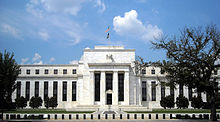| This article is part of a series on |
| Banking in the United States |
|---|

The monetary policy of The United States is the set of policies which the Federal Reserve follows to achieve its twin objectives of high employment and stable inflation.[1]
The US central bank, The Federal Reserve System, colloquially known as "The Fed", was created in 1913 by the Federal Reserve Act as the monetary authority of the United States. The Federal Reserve's board of governors along with the Federal Open Market Committee (FOMC) are consequently the primary arbiters of monetary policy in the United States.
The U.S. Congress has established three key objectives for monetary policy in the Federal Reserve Act: maximizing employment, stabilizing prices, and moderating long-term interest rates. Because long-term interest rates remain moderate in a stable economy with low expected inflation, the last objective will be fulfilled automatically together with the first two ones, so that the objectives are often referred to as a dual mandate of promoting maximum employment and stable prices. The Fed operationalizes its objective of stable prices as following an inflation target of 2% annual inflation on average.[1]
The Federal Reserve's main monetary policy instrument is its Federal funds rate target. By adjusting this target, the Fed affects a wide range of market interest rates and in turn indirectly affects stock prices, wealth and currency exchange rates. Through these variables, monetary policy influences spending, investment, production, employment and inflation in the United States. These channels are collectively known as the monetary transmission mechanism. Effective monetary policy complements fiscal policy to support economic stability, dampening the impact of business cycles.
Besides conducting monetary policy, the Fed is tasked to promote the stability of the financial system and regulate financial institutions, and to act as lender of last resort.[2][3] In addition, the Fed should foster safety and efficiency in the payment and settlement system and promote consumer protection and community development.[1]
- ^ a b c "The Fed Explained: What the Central Bank Does" (PDF). www.federalreserve.gov. Federal Reserve System Publication. August 2021. Retrieved 3 August 2023.
- ^ "Federal Reserve Board - Purposes & Functions".
- ^ "The Federal Reserve System Purposes & Functions - Section 3" (PDF). federalreserve.gov.
© MMXXIII Rich X Search. We shall prevail. All rights reserved. Rich X Search
